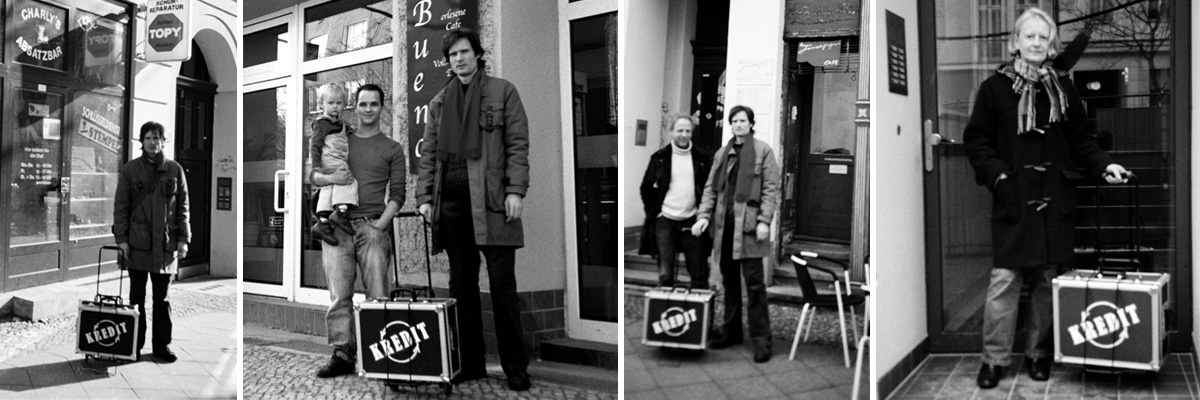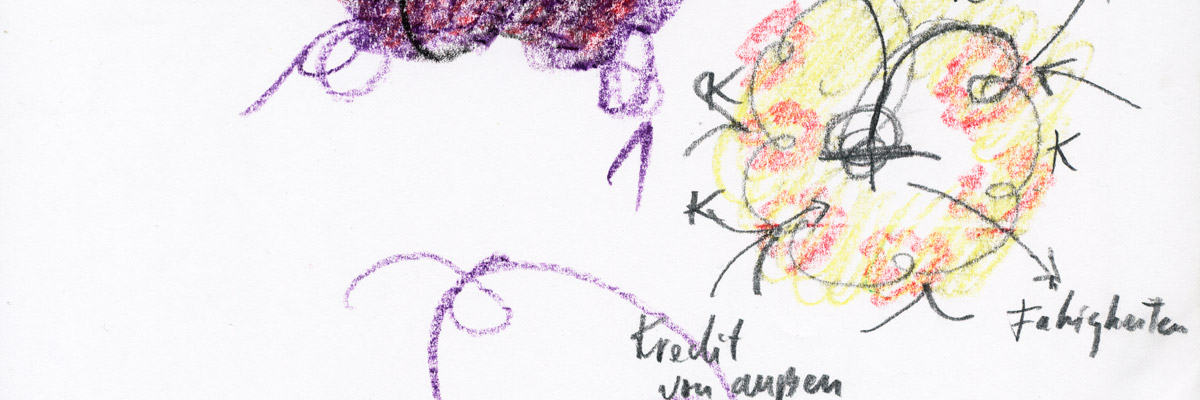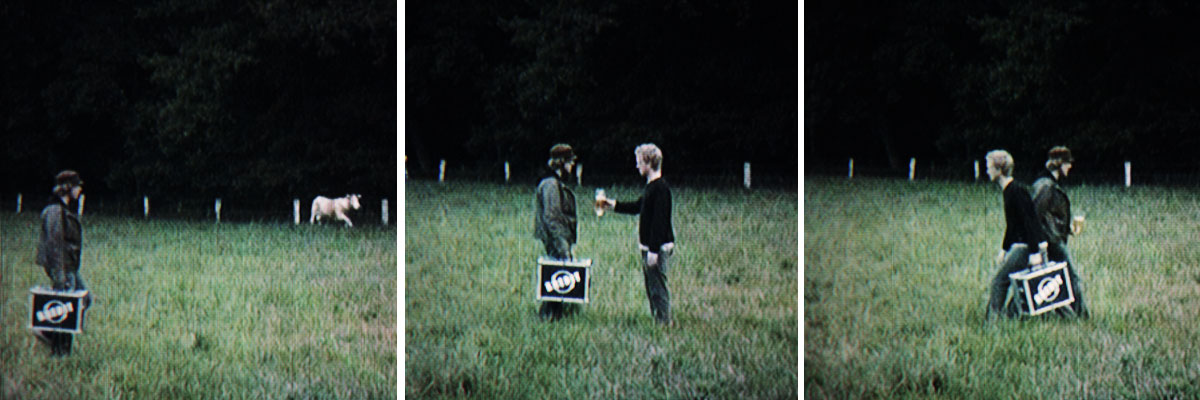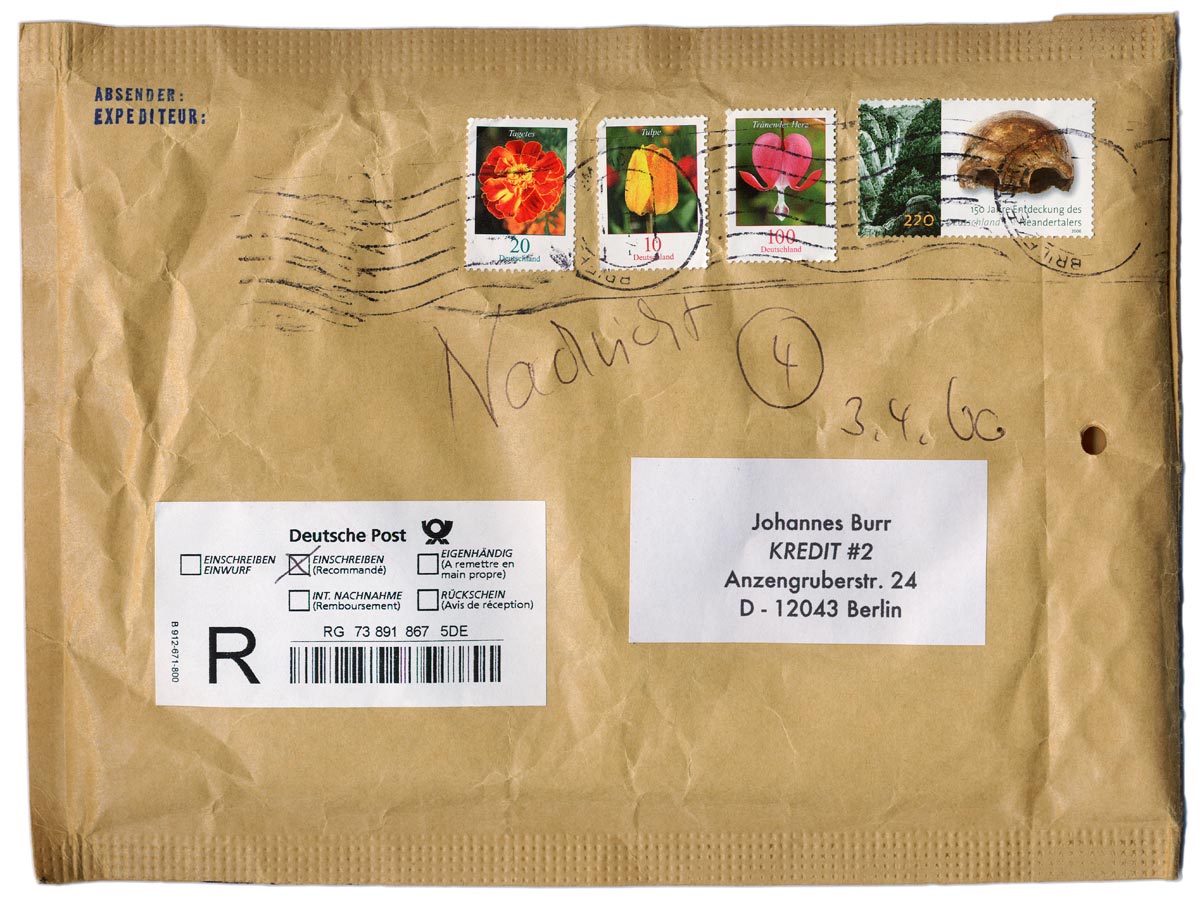Congratulations on receiving the CREDIT Case!
You now have seven days to film whatever you like using the camcorder from the CREDIT Case. The only condition: you only have a 30 minute long video cassette at your disposition and you must complete the four tasks listed below. Everything else is up to you and your imagination.
The CREDIT Case is a project initiated by Johannes Burr (the Credit Bank, aimed at exploring new ways of collaboration and investigating the conditions under which art comes into being.
Once brought into circuit, the CREDIT case will be passed on from person to person, before returning to the credit bank after a certain time of circulation. The video recordings evolved during the credit circulation by individual beneficiarie’s interactions are then compiled into a Chain Film and published in limited edition. Each borrower will receive a copy of the chain film.
At the end of the project, all participants will meet for a shared meal. Later, the chain film is to be presented to the public as part of an exhibition.
ou are now also a borrower and can use this credit in the form of video camera equipment to create something new. Aside from this right you also have duties, as listed further down, which you are asked to comply with.
Credit; from the Latin: credere, translates as: to entrust, to believe, to confide.
Enjoy!

CREDIT Case instruction manual
1.
Check the contents of the case for completeness, according to the inventory list on the inside of the case lid. Report any missing items to the credit bank immediately: info@wp.kreditprojekt.org
2.
Take a threefold copy of the contract from the case lid, read it carefully, fill in your name, address, and phone number in the designated fields on all three sheets, and then sign them together with your creditor. The copy numbered 2 will remain with you as a receipt.
3.
Have your creditor show you how to use the camera, or read the CAMCORDER instruction manual for this purpose. A complete documentation of the camera’s functions in your language can be found here.
4.
Take the cassette with the lowest number from the case and insert it into the camcorder. Turn on the camcorder, press “Record”, and let it run for about 20 seconds. This is important because, for technical reasons, the recording at the very beginning of the tape cannot be used.
5.
TASK 1
Realise your first video recording together with your creditor. Anything is possible: staged, documentary, narrative or abstract, altogether subjective or as objective as possible like a reportage, from a few seconds to several minutes. Let your imagination run free. The one thing of importance is: your shared ideas must be implemented together and consensually. The help of others may be used.

6.
TASK 2
Find a quiet and well-lit place, e.g., in your home. Mount the camcorder on the tripod by screwing the tripod’s quick-release plate onto the bottom of the camera with a coin and then clamping the camera onto the tripod. Stand or sit in front of the camcorder so that you fill the frame. Whether you choose a portrait, full-body shot, or something in between is up to you. You can rotate the camcorder’s monitor by 180° to see your image and adjust your position. hen, answer the following questions while looking into the camera. Once you’ve answered the questions, remain still for exactly one more minute in front of the camera, just as you are.
Please answer the following four questions:
- What is your name? (First name is sufficient)
- How old are you?
- What is your current occupation/profession?
- What is art to you?
Now remain still in front of the camera for one minute, just as you are.
7.
TASK 3
Portray a location that you associate with a positive or a negative experience. Tell the story of that place or reenact it, or have others reenact it. What’s important is that you present this place.
8.
Should the seven days since you received the CREDIT Case have not yet passed and there is still space left on your video cassette, then you now have both—the remaining days and the unused tape minutes—at your free disposal. Make the most of it!
9.
Please note: If you are the last, seventh borrower (this will be the case, if only have one threefold contract copy, one cassette and no jiffy bag left in the suitcase), then please contact the Credit Bank not later than the seventh day, in order to arrange the return of the case: info@wp.kreditprojekt.org
Skip the following paragraphs and read on at section 14.

10.
If you are not yet the last borrower, please continue reading here:
No later than the seventh day after receiving the CREDIT Case, you must have found a successor to hand the CREDIT Case over to. Any person can be a successor and thus a new borrower, as long as they have your confidence and are able to meet the conditions of the contract. For persons under the age of 18 the respective legal guardian (e.g. a parent) will sign the contract and mind its implementation.
11.
Before handing over the CREDIT Case, please recharge both battery packs (see the CAMCORDER instruction manual for this).
12.
en explain the CREDIT Case and its use to your successor. Take out a new threefold copy of the contract from the case’s lid. Go over the contract together with the new borrower. Fill in the contract together in three copies and sign it. The copy numbered 1 (for the creditor) will remain with you as a receipt.
13.
Extract one of the franked jiffy bags from the CREDIT Case. Write your name and address as an addresser in the upper left corner of the envelope. Then insert your video cassette and the third copy of the contract, filled out by yourself and the new borrower, into the envelope and seal it off. Bring it then in the course of the next few days to one of the counters of Deutsche Post. You won’t need to pay, the envelope is already franked sufficiently!
14.
TASK 4
Now realise together with your borrower their first video recording, as you did with your creditor in task 1. Even this time the following applies: your shared ideas must be implemented together and consensually. The help of others may be used.
15.
That’s it! Thank you for participating! The Credit Bank will get back to you at the end of the project.
